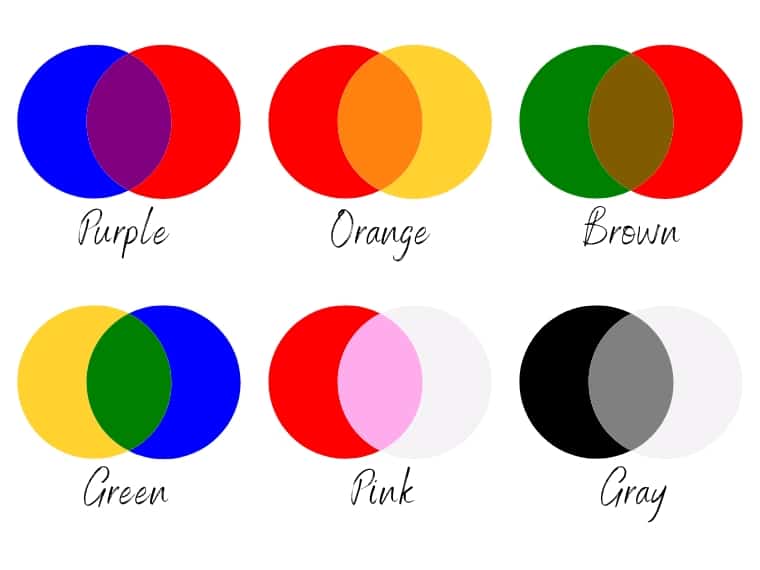Looking for a color mixing chart? Here’s a comprehensive guide to what colors make purple, red, orange, pink, blue, green, yellow, and brown.
Even though there are various colors in terms of paints, it is difficult to purchase them all. Therefore, the easiest way to make a color is to use a color mixing chart and get the desired shade by mixing other colors.
Why do you need a color mixing guide? Because of the three types of cones in the human eye, humans can see up to ten million colors.
However, a limited number of colors are available in art, especially in prepackaged kits. Furthermore, you need a color mixing chart when you want to create other colors just from primary colors. So it’s essential to know how to create your desired colors by mixing other colors.
What’s more, by mixing the colors below, you can benefit from many shades without buying them.
When it comes to light, there are 16,777,216 different colors. For all primary colors (red, green, and blue), the RGB model employs 8 bits ranging from 0 to 23. Each of them has a value between 0 and 255. This means that there are 16,777,216 different colors.
Here’s how it works: 256 possible red shades, 256 possible green shades, and 256 possible blue shades = 256 x 256 x 256 = 16,777,216 colors.
Let’s find out more about color mixing combinations.
Color Theory
To learn how to mix colours, it’s worth taking a look at colour theory. So to save time, here is a brief summary.
What Are Primary Colors?
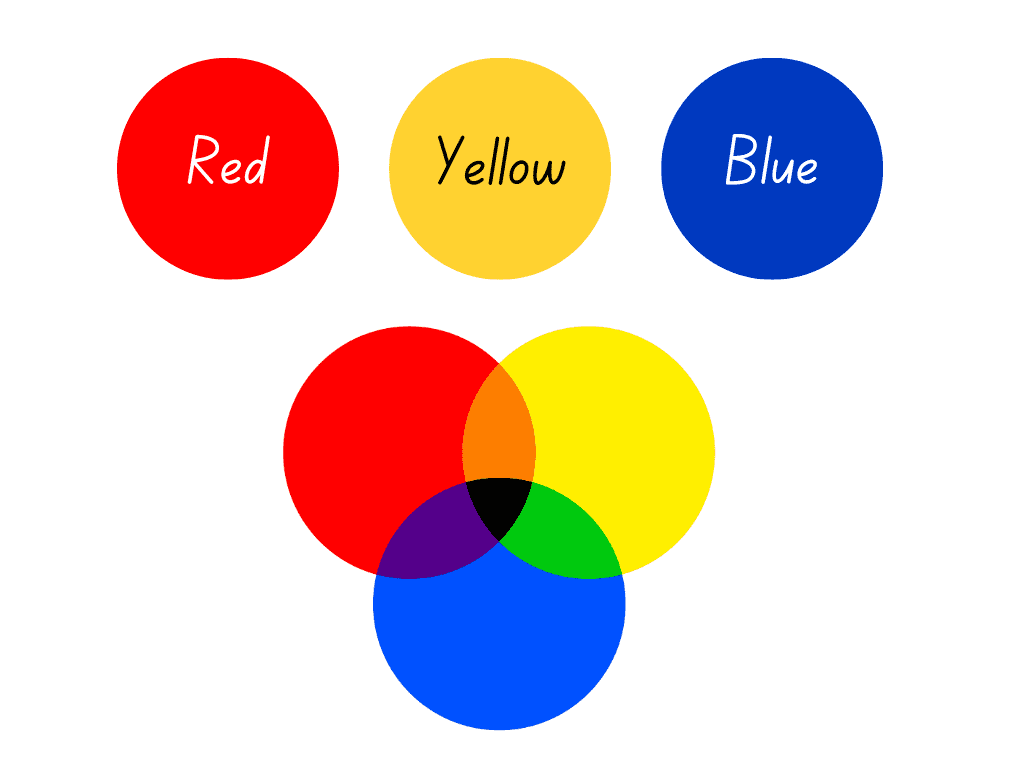
The primary colors are actually three colors that are not mixable, so they cannot be created by mixing other colors. So by mixing them and maybe using white, you can create any color.
The three primary colors in painting are:
- Red
- Yellow
- Blue
Mixing of Secondary Colors

Secondary colors are colors created by mixing two primary colors.
The secondary colors you can mix are:
- Green: Blue and yellow
- Orange: Red and yellow
- Purple: Red and blue
When mixing colors, it’s important which primary colors you choose. That means there are many types of red, yellow and blue shades. Some are cooler, others warmer. Thus, any primary color has a color bias, i.e. it leans towards another color.
If you mix all the primary colors, you get black.
Mixing of Tertiary Colors
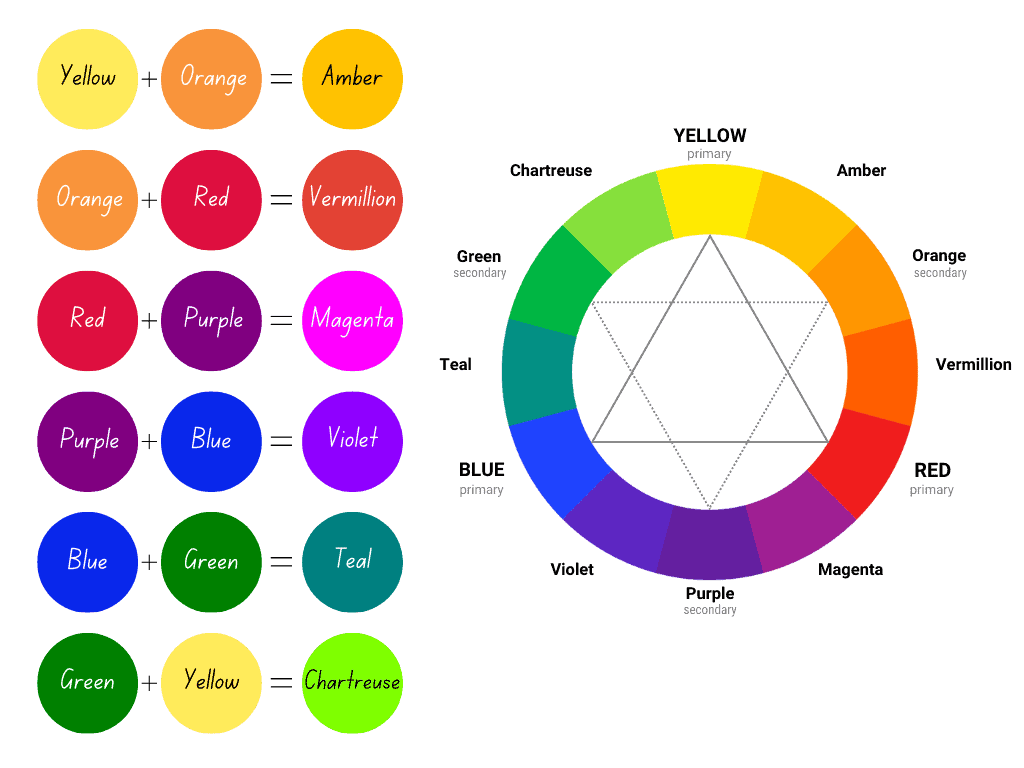
Tertiary colors are created by mixing a primary with a secondary color. However, according to another definition, tertiary colors (in painting) are mixtures of two secondary colors. Those often referred to as tertiary colors are rather intermediate colors.
Intermediate colors are mixtures of two adjacent colors, a primary with a secondary color. Thus, the only rule is that they must be located next to each other on the color wheel.
Intermediate colors include:
- Yellow-Orange (Amber)
- Red-Orange (Vermillion)
- Red-Purple (Magenta)
- Blue-Purple (Violet)
- Blue-Green (Teal)
- Yellow-Green (Chartreuse)
As they are often found in nature, they are essential, especially when you want to make artwork with a natural look.
Complementary Colors
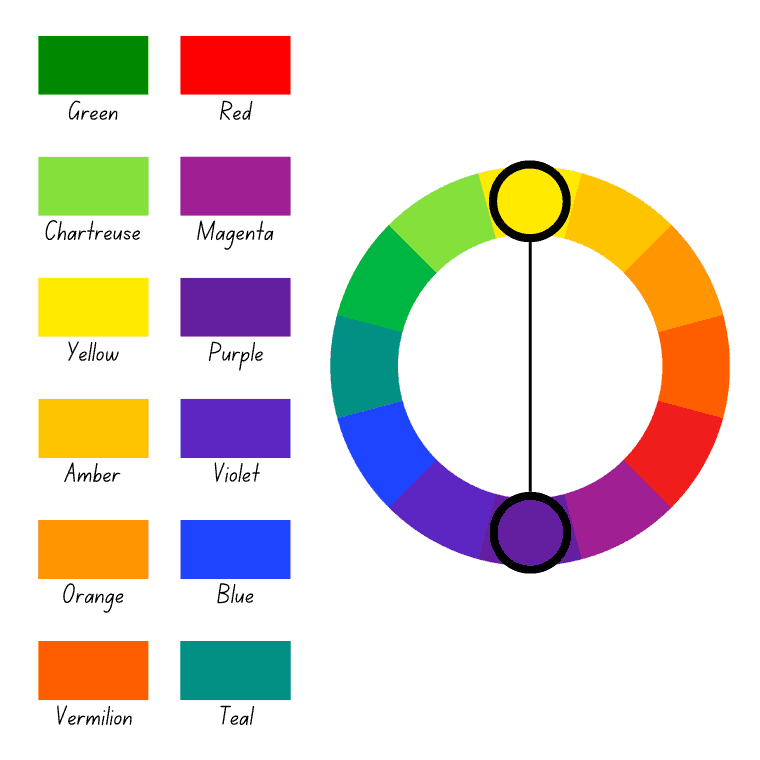
Complementary colors are the colors opposite each other on the color wheel. They are the most basic type of color harmony. When combined, they provide high contrast.
The complementary colors of the primaries are known as primary complementary colors. So what are they?
- The complementary color of purple is yellow
- The complementary color of orange is blue
- The complementary color of green is red
Color Mixing Wheel
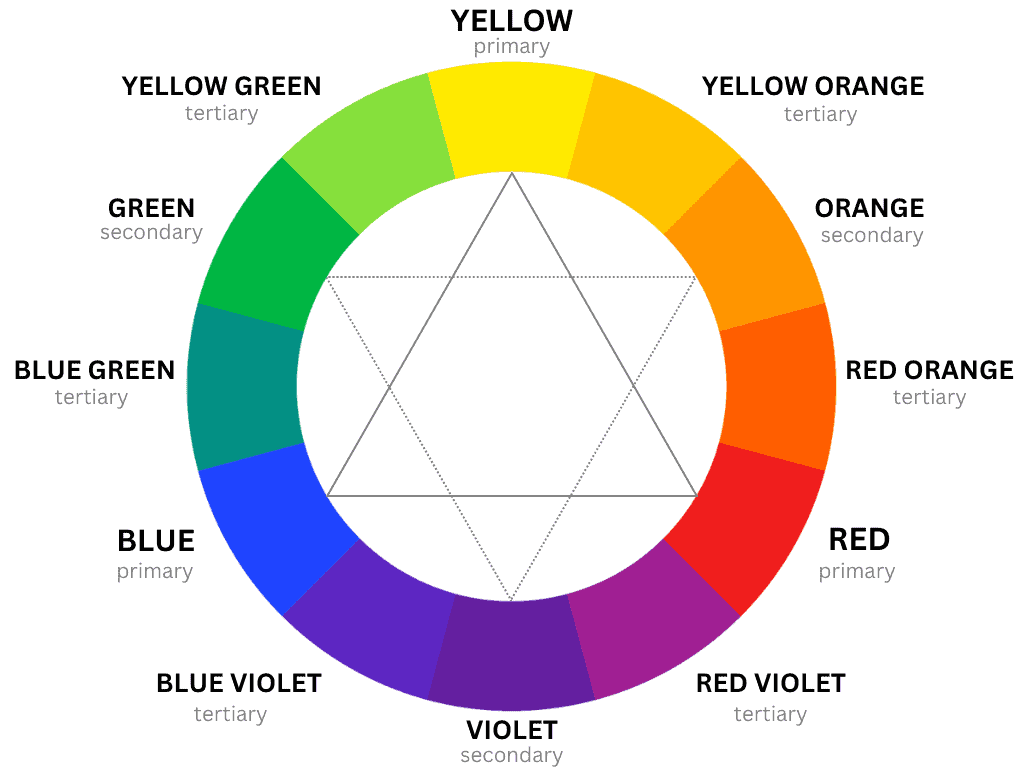
What Colors Make Red?
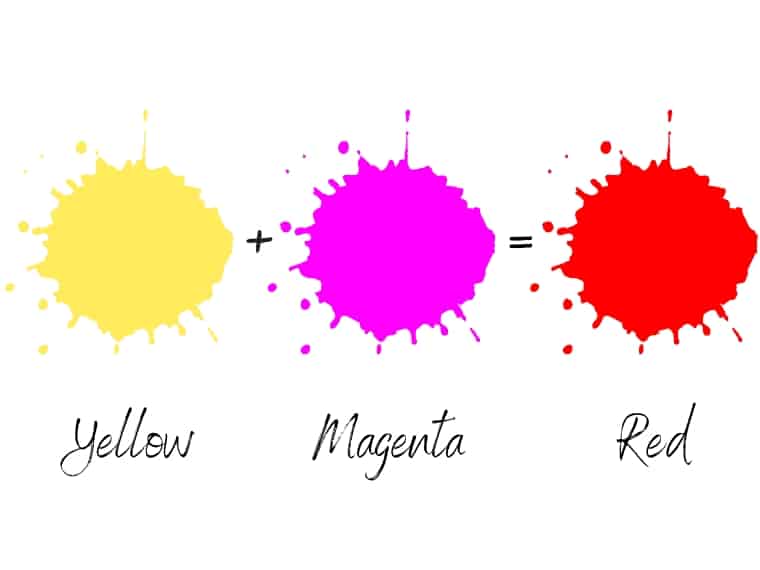
Red is a primary color in both the RYB and RGB models, so you can’t create it by mixing other colors. But to make it clear, red cannot be created using additive color mixing.
When it comes to printing, things are quite different.
To make red, mix yellow and magenta in a 1:1 ratio. According to the CMYK model, red can be created by combining these two colors.
What Colors Make Green?

Green is a primary color in the RGB model, which deals with light. However, when it comes to opaque pigments and paints (RYB), things are different.
The way to make green is by mixing yellow and blue in an equal ratio.
If you increase the amount of blue, you will get a blue-green shade, while if you increase the yellow, you will get a yellow-green.
According to the CMYK model, green can be obtained by mixing cyan and yellow.
What’s interesting is that green is the most common color in nature due to the chlorophyll content, a green pigment in plants. So, there are plenty of green things in nature.
What Colors Make Blue?
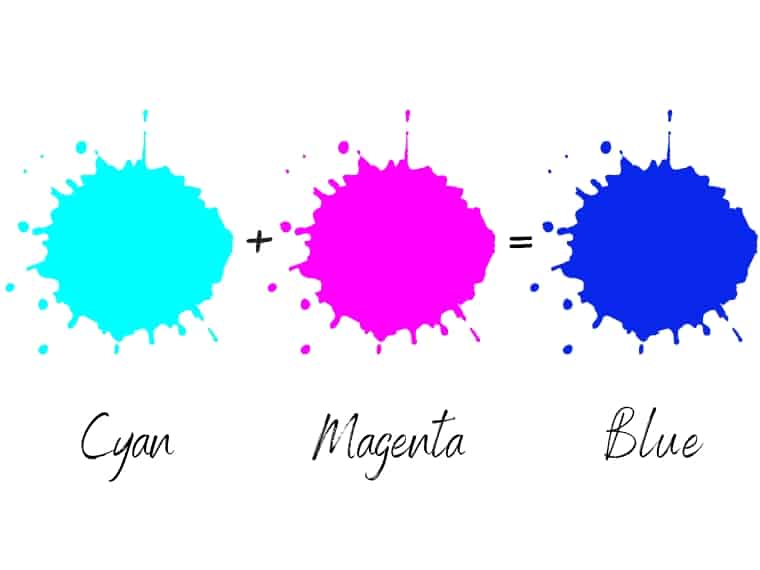
Blue is a primary color in both the RYB and RGB color spaces. Therefore, when it comes to color mixing, blue is in the same situation as red: it cannot be created by mixing other colors.
To make shades of blue, you should add a little black. That way, you can get midnight blue or navy blue. On the other hand, add some white paint to make a hint of blue, like cerulean blue.
To make sky blue, you can mix ultramarine blue and titanium white.
Learn more about what colors make blue in all color models.
What Colors Make Yellow?
Yellow is a primary color in RYB and CMYK models, meaning it cannot be made by mixing other colors. However, when it comes to light, yellow is a secondary color.
Yellow can only be created in the additive model, known as RGB. To make yellow, overlay green light and red light.
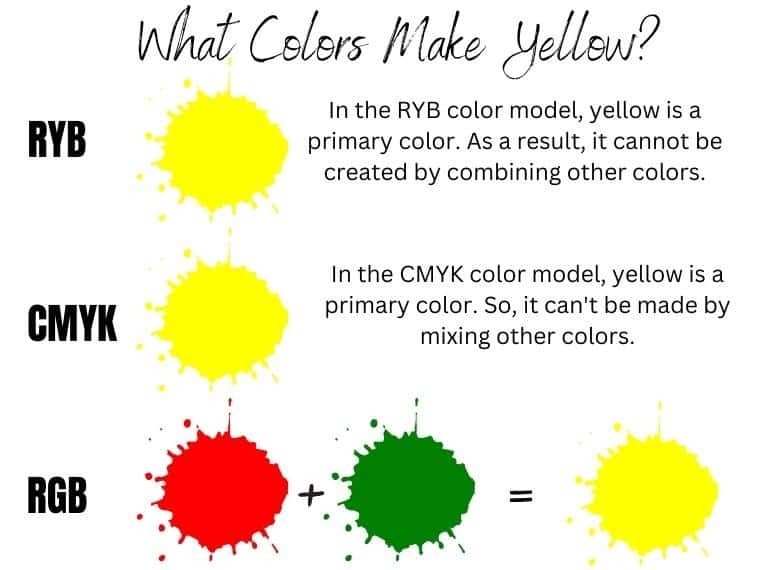
Yellow is one of the oldest pigments in traditional art, thanks to yellow ochre.
What Colors Make Orange?
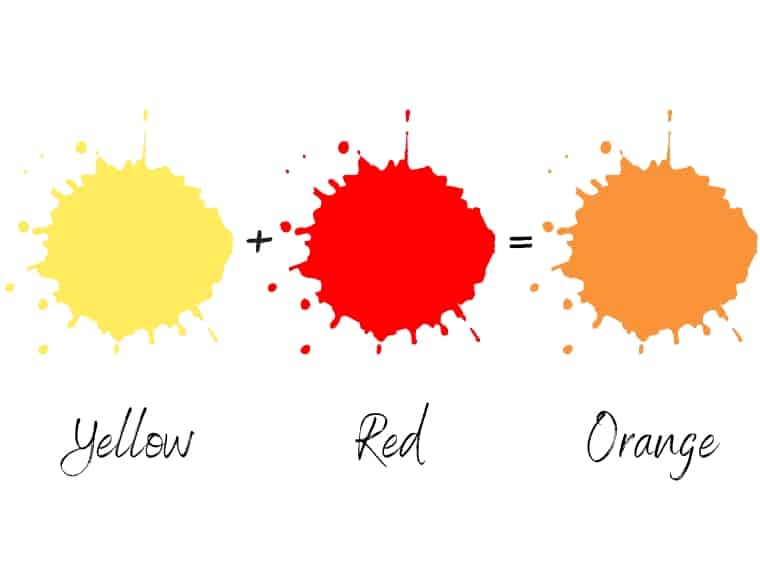
Curious about what colors make orange?
Orange is a secondary color located between red and yellow on the traditional color wheel. Therefore, to make orange, mix red and yellow together.
If you add more red to the mixture, you get an intermediate color known as red-orange, while more yellow paint produces a yellow-orange color.
Thus, red and orange make vermilion, a red-orange color.
The name of this color comes from the citrus fruit. Before it had this official name, the color was known as yellow-red.
What Colors Make Purple or Violet?
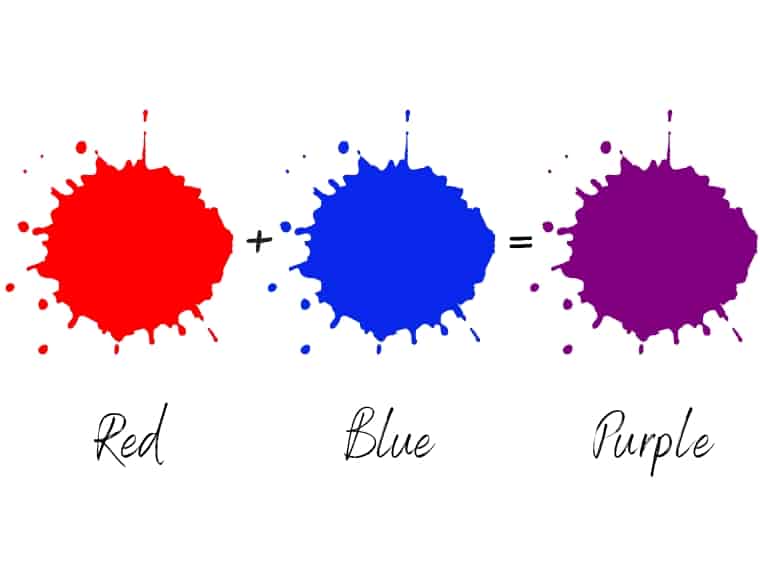
Violet is believed to have appeared in art since Neolithic times. Prehistoric artists in France used sticks of hematite and manganese powder to paint cave walls. These paintings date between 16,000 and 25,000 BC.
When it comes to purple pigment, things get more interesting.
The purple pigment was produced from Bilinus brandaris sea snails. The mucus was harvested from the shells of these snails and heated in an alkaline solution. It was then exposed to sunlight, and the purple pigment appeared. This pigment is known as Tyrian violet.
Because it was challenging to produce, the purple pigment was costly. So only the upper classes, such as nobles, kings, and queens, could afford it. For this reason, it was associated with royalty.
But what colors make purple? Purple is a secondary color in the RYB color model.
Mixing red and blue in equal proportions makes purple. Start with red paint as the base and add a splash of blue paint.
If you use more red in the mixture, you’ll get magenta, a reddish shade of purple.
So, if you’re wondering what makes purple, you need to mix red and blue. However, you can get different shades of purple depending on the types of paint you use in the mix.
Keeping in mind the color harmony, purple pairs well with yellow.
What Colors Make Pink?
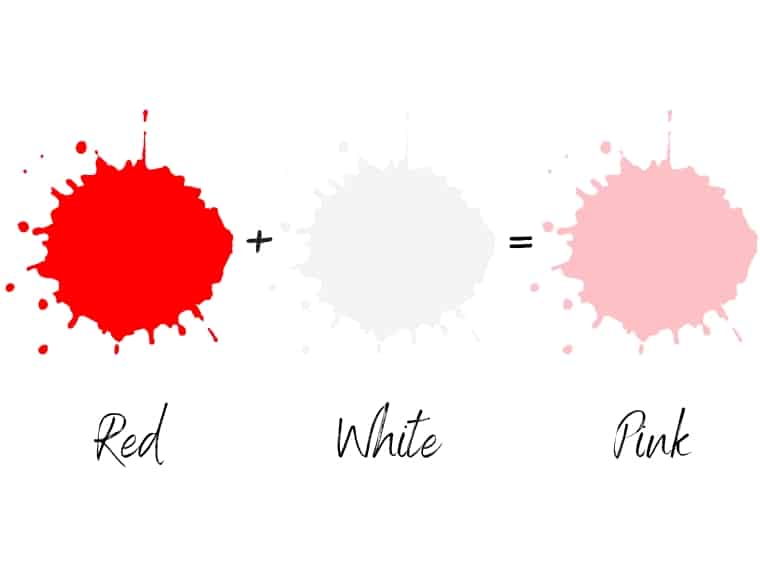
Pink is a hint of red, which means it can be made by mixing red with white.
If you want to make pink without white, mix light yellow with red paint. This will produce a shade of pink similar to peach or coral pink.
If you want to create a vibrant pink, mix magenta and white.
So you can make pink without red, just as you can achieve pink without white.
Depending on the colors used, you can get different shades of pink. For example, if you want to make a dark pink, you can mix Light Alizarin Crimson or Light Cadmium Red with Burnt Umber.
To get a light pink, mix Light Alizarin Crimson with Cadmium Yellow and white.
If you want to achieve a warmer pink, mix Light Cadmium Red or Light Alizarin Crimson with Cadmium Yellow.
To make dusty pink, mix a soft pink with a little black.
Pink has been a disputed color in history. In old books, pink is the color of little boys. Although before World War II, it was a boy’s color, it was later assigned to girls by toy retailers.
Today, pink is associated with kindness, love, innocence, and gentleness.
What Colors Make Brown?
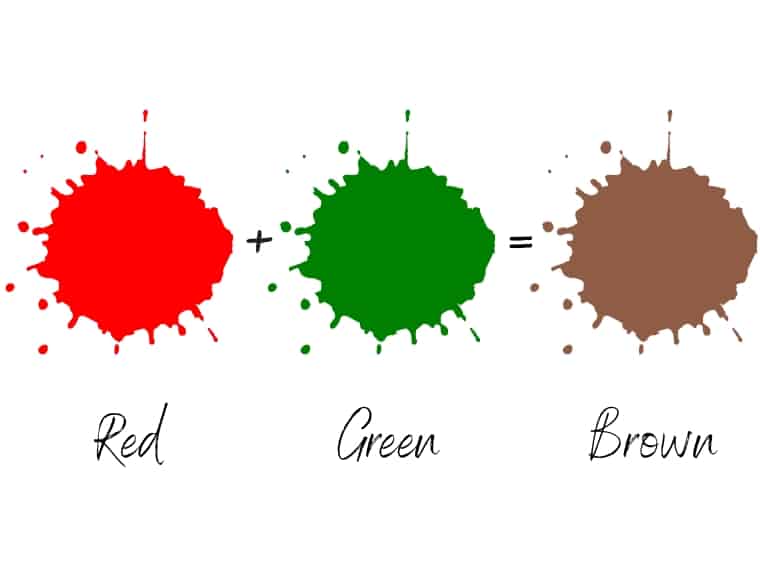
Brown is the color of soil and wood, which evokes comfort and stability.
But what two colors make brown?
Brown is created by mixing the primary color red and the secondary color green.
Interestingly, by mixing complementary colors on the traditional color wheel, you get different shades of brown.
What Colors Make Gray?
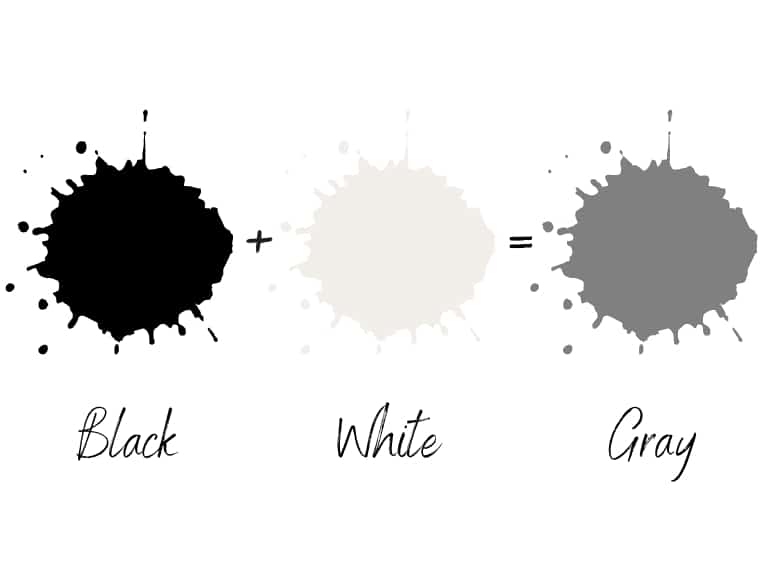
Gray is more than a color; it is a spectrum of colors between black and white.
If you want to know what two colors make gray, mix a little black into a white base until you reach the desired shade of gray.
If you want to know what colors make gray without white, the answer is complementary colors. Therefore, you can mix red and green, orange and blue, or purple and yellow in equal proportions to make gray.
Interestingly, when you combine the complementary colors, you mix all the primary colors of the RYB model. So, another easy way to make gray is to combine blue, red, and yellow together.
This way, you can make gray without black and white.
What Colors Make Turquoise?
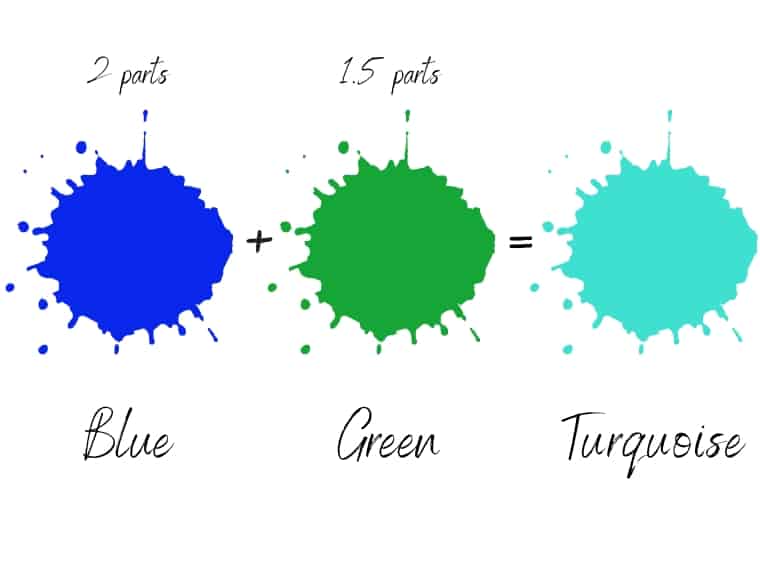
Turquoise can be made by mixing green and blue. As turquoise contains more blue, it is advisable to use a 2:1.5 ratio of blue and green in the mixture. Using an equal proportion of blue and green will produce teal, darker than turquoise.
Turquoise is a color located on the color palette between green and blue.
To make a pale turquoise, use a very pale blue in the mixture. Alternatively, mix blue and green as a base and add white or yellow to achieve the desired shade.
You can make turquoise by mixing green and blue paint with a color bias toward green. For example, mix green with cyan, cobalt, ultramarine, or cerulean.
If you want to create a darker shade of turquoise, add a little gray-white.
What Colors Make Cyan?
Cyan is a primary color in the CMYK space – a subtractive color model. This means that cyan cannot be created by mixing other colors.
However, in painting, combining blue and white makes cyan.
You can also make cyan by mixing blue and green, which produces a turquoise base. Next, add a little yellow, and then add white until you reach the desired shade of cyan.
What Colors Make White?
To make white, you need to use additive color mixing. This means that to make white, you need to mix colored lights, not pigments or dyes.
Additive color starts with darkness (black), while subtractive color starts with white (a piece of paper). However, as more and more colors are mixed, the resulting color becomes darker and tends toward black rather than white.
This is because with subtractive color mixing, the more colors added, the more wavelengths of light are absorbed by the pigments or dyes, which reduces the amount of light that is reflected back to you. As a result, the subtractive color ends with black.
In contrast, with additive color mixing, adding more colors creates brighter and more vibrant colors and ends with white.
Thus, it is impossible to create white in subtractive color mixing.
When it comes to light, white can be created by mixing the primary colors, red, green, and blue.
What Colors Make Black?
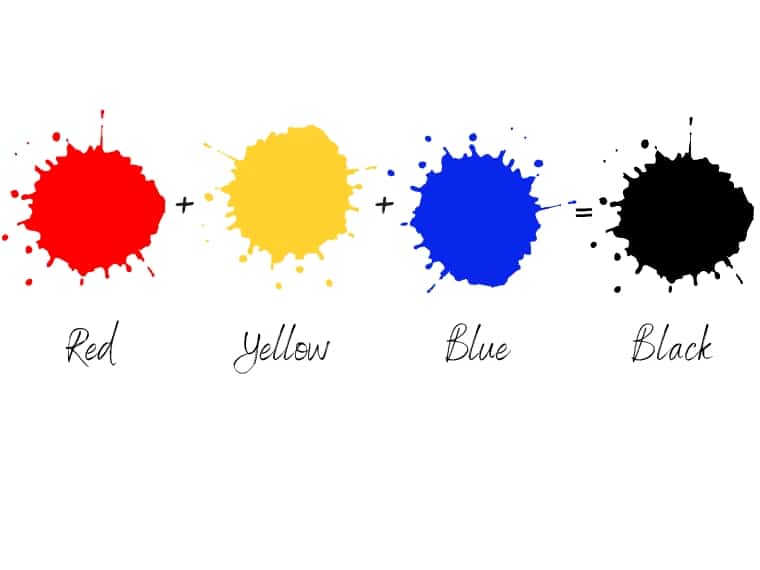
Wondering what colors make black?
Black paint can be made by mixing the three primary colors of the RYB color space: red, yellow, and blue.
In subtractive color mixing, which uses pigments or dyes to create colors, mixing all colors in equal parts produces black.
This is because each color pigment absorbs specific wavelengths of light and reflects others. When all colors are combined, they absorb all wavelengths of light, resulting in a lack of color and the perception of black.
Regarding additive color mixing (RGB color space), black is the absence of light.
Color Mixing Chart
Here’s a color mixing chart using two color combinations:
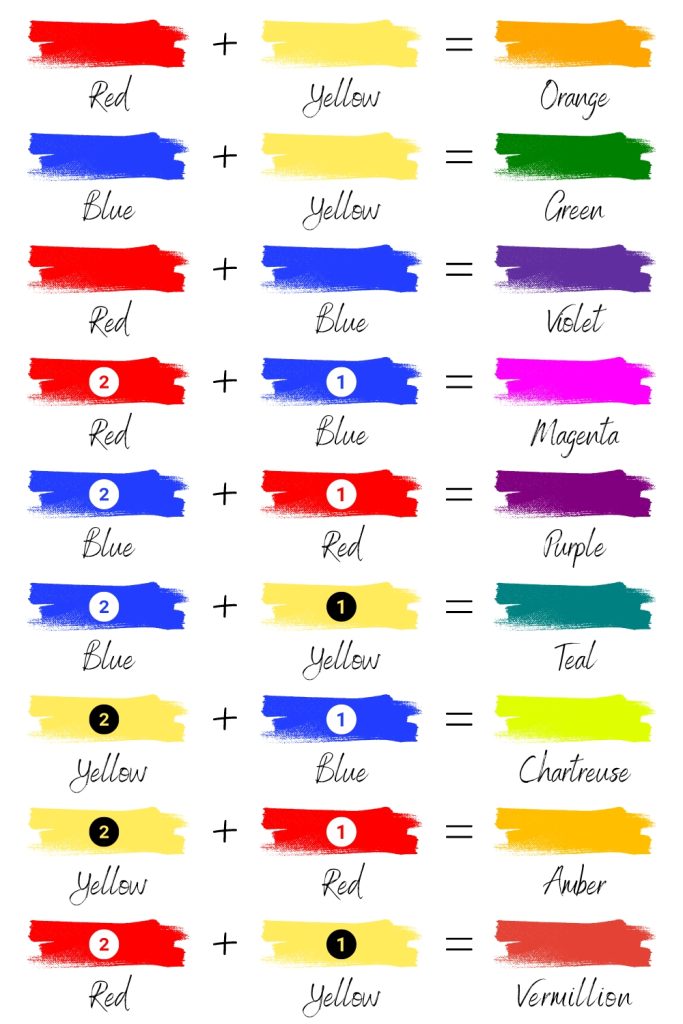
Need more? Here’s a color mixing guide using three colors:
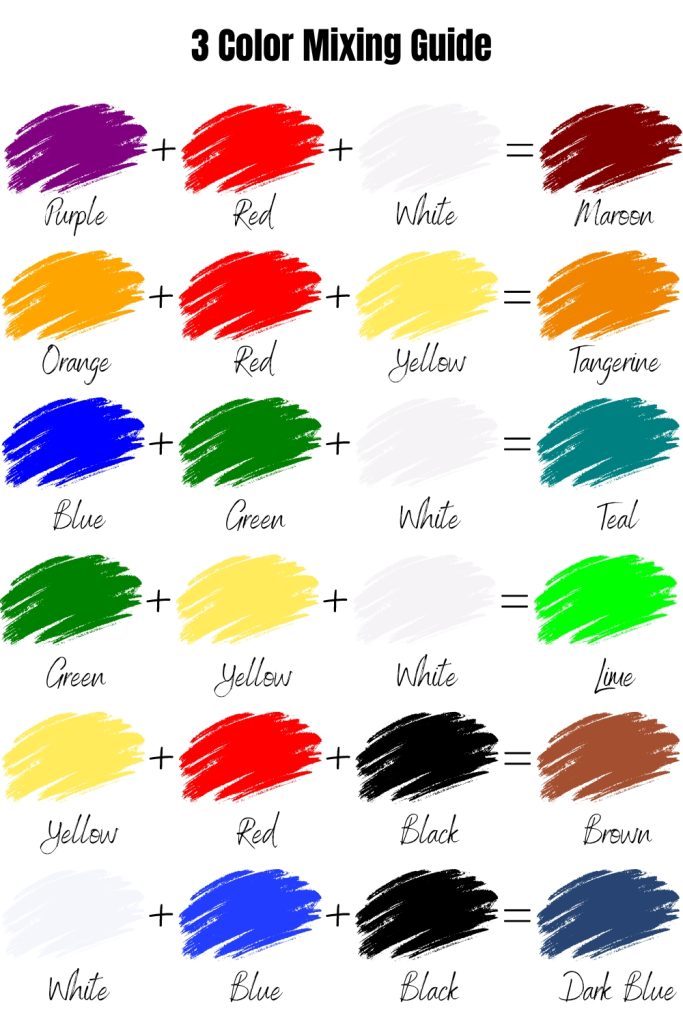
Additive and Subtractive Color Mixing
Subtractive and additive color mixing are two different ways of creating colors.
Subtractive color mixing creates colors by subtracting specific wavelengths of light from the visible spectrum. This process is used in printing, painting, and other forms of color mixing, where pigments or dyes are used to create colors.
Subtractive colors are considered the primary colors of the CMYK or RYB color models.
As more and more colors are mixed together, the resulting color becomes darker and tends toward black. So, the subtractive color starts with white and ends with black.
On the other hand, additive color mixing is the process of creating colors by adding different wavelengths of light together. This is used in digital screens, like smartphones, televisions, or computer screens.
The primary colors used in this type of color mixing are red, green, and blue.
Additive color starts with black (darkness) and ends with white. Adding more light to the mixture results in brighter colors.
Thus, there is a main difference between these two types of mixing colors.
Subtractive color mixing involves absorbing light, while additive color mixing involves emitting light.
Last Words on Color Mixing Chart Guide
Whether or not you have secondary, intermediate, or tertiary colors as paints, they can be created from combinations of two or three colors. We hope this color mixing chart guide will help you reach the color you want.
Did you enjoy this color mixing chart article? Share it with your friends to help us spread the word.

